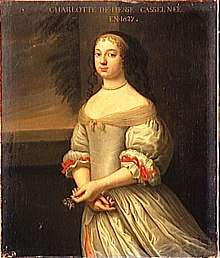Landgravine Charlotte of Hesse-Kassel
Charlotte of Hesse-Kassel (20 November 1627 – 26 March 1686) was the consort of Charles I Louis, Elector Palatine and mother of Elizabeth Charlotte of the Palatinate.
| Charlotte of Hesse-Kassel | |
|---|---|
| Electress Palatine | |
 Charlotte in 1650, by the Atelier of the Beaubrun Brothers | |
| Born | 20 November 1627 Heidelberg Castle, Heidelberg, Baden-Württemberg, Germany |
| Died | 26 March 1686 (aged 58) Heidelberg Castle, Heidelberg, Germany |
| Spouse | Charles I Louis, Elector Palatine |
| Issue Detail | Charles, Elector Palatine Elizabeth Charlotte, Duchess of Orléans |
| House | Hesse-Kassel |
| Father | William V, Landgrave of Hesse-Kassel |
| Mother | Amalie Elisabeth of Hanau-Münzenberg |
| Religion | Calvinism |
Biography
Her parents were William V, Landgrave of Hesse-Kassel and Amalie Elisabeth of Hanau-Münzenberg. Her future marriage to her cousin Charles I Louis, Elector Palatine, was regarded as highly advantageous. However, her own mother warned the Elector of Charlotte's foul temper. She is described as a tall blonde girl, with long legs and a beautiful bust.
She married at Heidelberg Castle on 22 February 1650 Charles I Louis, Elector Palatine and had three children, two of whom survived infancy. At first all went well as Charles Louis became wildly infatuated with his wife and started his task of providing the Palatinate with an heir. According to his sister Sophia, 'his passion had impaired his intellect', though he was also quite jealous. If she criticised him, he would go into a rage but their quarrels were made up at night with audible violence.
Charlotte excelled at equestrian talents (as her daughter would), but Charles Louis objected to women on horseback. She loved gambling, which Charles Louis regarded as a waste of money.
To the joy of the Palatinate and Charles Louis, a son was born in 1651 and in 1652 a daughter. When Charles Louis went to the Electors' Diet in Prague, he infuriated Charlotte by not taking her. At this time the sixteen-year-old Marie Luise von Degenfeld came to their court, where she was regarded as not very pretty and naive. Marie Luise would become Charles Louis' mistress and starting in 1658, would bear him 13 children while he was still married to Charlotte.
After his return Charles Louis took his wife and his sisters, Elizabeth and Sophia, to the festivities accompanying the coronation of Archduke Charles as his father's successor. Charlotte was again furious, as she was pregnant and unable to wear the French dresses especially bought for the occasion. The baby died a few hours after birth and Charlotte was very ill and could not be moved for weeks.
In 1654 Charles Louis's brother, Prince Rupert, came to visit Heidelberg and soon Charlotte realised Rupert was in love with Marie Luise. In order to prevent nocturnal visits, Charlotte made Luise sleep in her bedroom. Trying to protect Luise from Rupert, she had not realised that her own husband had fallen in love with the same girl. However, one night Charlotte woke up and, maintaining that she had found her husband in bed with Luise, she attacked the girl, almost biting off her little finger. Charles Louis protected Luise and called in the guard to restrain Charlotte. The following day Charles Louis installed Luise in an apartment directly above his own, which was made accessible to him by a secret passage. Soon Charlotte found out and had to be prevented from ascending the same ladder with a knife in her hand.
From then onward, Charlotte maintained that she was kept a prisoner in her apartments. She beat her servants and, if they were found to be spying on her behalf, they were dismissed by her husband. Charles Louis made sure not to be anywhere near Charlotte, who was pitied by everyone. In accordance with his rights, he divorced Charlotte but kept this a secret until after his sister Sophia's wedding. As soon as these festivities were over, Charles Louis published the divorce documents and declared himself to be married to Louise von Degenfeld, though many questioned the legality of the divorce.
Charlotte ruined her relations with Sophia when she admitted that she had married Charles Louis against her own wishes, saying that she would have preferred several others over this 'jealous old man'. Soon it was Charlotte who became jealous of Sophie who seemed to be on much better terms with Charles Louis. Charlotte felt herself excluded from their conversations and never understood their jokes. As a result of her unhappy marriage, Charlotte's children were sent to live with their paternal aunt Sophia in Hanover.
After the divorce, Charlotte lived the next 23 years in obscurity, only to emerge after the death of Charles Louis, when their son became the next Elector Palatine. However, she remained difficult and ill-tempered until her death, six years later.
When Charlotte, after her death, was dressed for burial, Sophia commented that "it was the first time that she was dressed without attacking or hitting someone".
Issue
- Charles of the Palatinate (31 March 1651 – 26 May 1685) succeeded as Elector Palatine married, Princess Wilhelmina Ernestine of Denmark in 1671 but had no issue.
- Elisabeth Charlotte of the Palatinate (27 May 1652 – 8 December 1722) married Philippe of France, Duke of Orléans in 1671 and had issue.
- Frederick of the Palatinate (12 May 1653 – 13 May 1653) died in infancy.
Ancestry
| Ancestors of Landgravine Charlotte of Hesse-Kassel | |||||||||||||||||||||||||||||||||||||||||||||||||||||||||||||||||||||||||||||||||||||||||||||||||||||||||||||||||||||||||||||||||||||||||||||||||||||||||||||||||||||||||||||||||||||||||||||||||||||||||||||||||||||||||||||||||||||||||||||||||||||||||||||||||||||||||||||||||||||||||
|---|---|---|---|---|---|---|---|---|---|---|---|---|---|---|---|---|---|---|---|---|---|---|---|---|---|---|---|---|---|---|---|---|---|---|---|---|---|---|---|---|---|---|---|---|---|---|---|---|---|---|---|---|---|---|---|---|---|---|---|---|---|---|---|---|---|---|---|---|---|---|---|---|---|---|---|---|---|---|---|---|---|---|---|---|---|---|---|---|---|---|---|---|---|---|---|---|---|---|---|---|---|---|---|---|---|---|---|---|---|---|---|---|---|---|---|---|---|---|---|---|---|---|---|---|---|---|---|---|---|---|---|---|---|---|---|---|---|---|---|---|---|---|---|---|---|---|---|---|---|---|---|---|---|---|---|---|---|---|---|---|---|---|---|---|---|---|---|---|---|---|---|---|---|---|---|---|---|---|---|---|---|---|---|---|---|---|---|---|---|---|---|---|---|---|---|---|---|---|---|---|---|---|---|---|---|---|---|---|---|---|---|---|---|---|---|---|---|---|---|---|---|---|---|---|---|---|---|---|---|---|---|---|---|---|---|---|---|---|---|---|---|---|---|---|---|---|---|---|---|---|---|---|---|---|---|---|---|---|---|---|---|---|---|---|---|---|---|---|---|---|---|---|---|---|---|---|---|---|---|---|---|
| |||||||||||||||||||||||||||||||||||||||||||||||||||||||||||||||||||||||||||||||||||||||||||||||||||||||||||||||||||||||||||||||||||||||||||||||||||||||||||||||||||||||||||||||||||||||||||||||||||||||||||||||||||||||||||||||||||||||||||||||||||||||||||||||||||||||||||||||||||||||||
References and notes
| Preceded by Maria Anna of Austria |
Electress Palatine 22 February 1650 – 1657 |
Succeeded by Wilhelmina Ernestine of Denmark |